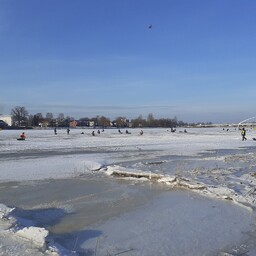In recent weeks, the media has covered the ice conditions of the past winter. For example, about the prohibition of going on the ice, fishermen on the ice, ice skating on sea ice, the duration of the ice season, the thickness of the ice, and the impact of climate change on sea ice. All these topics are united by the need for accurate information on ice conditions. This was written by Tallinn University of Technology researchers Mariliis Kõuts and Rivo Uiboupin.
According to the new climate service data, a persistent and extensive ice cover did not form in the Baltic Sea this winter. Ice formation on the sea began slightly later than average, at the beginning of January. The extent of ice cover this year was between the 2019/2020 minimum and the 30-year average. The ice cover was less than 100,000 square kilometers, or less than a quarter of the Baltic Sea's area.
The remote sensing climate service of Tallinn University of Technology allows monitoring the ice conditions of the Baltic Sea and comparing them with previous years. The website provides maps of ice distribution and ice formation probability. It is also possible to compare the extent of ice with the long-term (30-year) climatological average. The service provides information both in satellite images and in the form of graphs.
The peak moment of ice extent was around February 20, when the ice covered nearly 95,000 square kilometers. After the Republic's anniversary, the ice cover began to melt rapidly as the weather warmed up. This year's short ice period mainly covered narrow coastal areas. Northern Estonia was almost ice-free. By March 12, the ice extent had decreased to the same small size as in mid-March of the 2019/2020 warm winter.
March was warmer than usual. The sea surface temperature in the sea area surrounding Estonia is up to three degrees higher than the 30-year average. This is a significant difference from a climate perspective. As a result, a warmer area has also formed in the sea.
Sea ice plays a significant role in the Baltic Sea ecosystem. It affects both animals and humans. For example, ringed seals and grey seals need ice for breeding. Grey seals can adapt, but the lack of ice is a major problem for ringed seals. In years of poor ice conditions, about one-third of grey seal pups die, while 80-90 percent of ringed seal pups do not survive.
Ice fishermen are also connected to sea ice. They gather in few places where the ice is strong enough. On the Pärnu River, the rapid melting of the ice was evident during the ice jam. A week later, there was already a ban on going on the ice.
Due to climate change, we must get used to decreasing sea ice. However, we cannot simplify this issue. In the future, there may still be winters with abundant ice, which offer opportunities for winter tourism and affect the infrastructure of the sea and coast – ports, shipping, and icebreaking service planning.
The Baltic Sea ice cover climate service uses data from the Copernicus Marine Service. The service also contributes to climate change adaptation in Estonia and the development of the digital twin of marine renewable energy.

